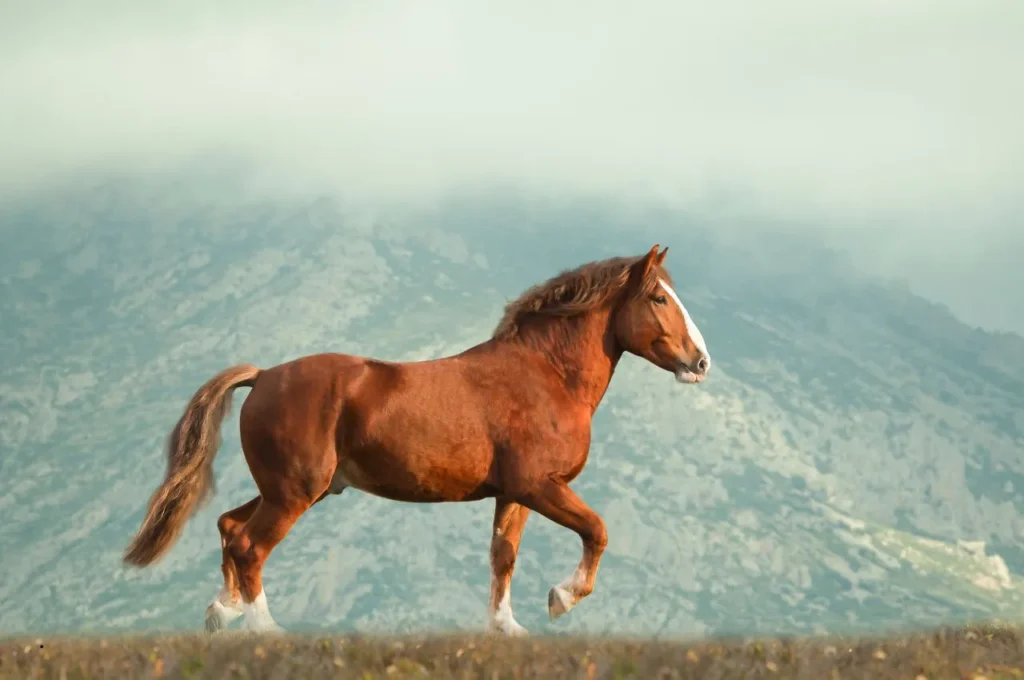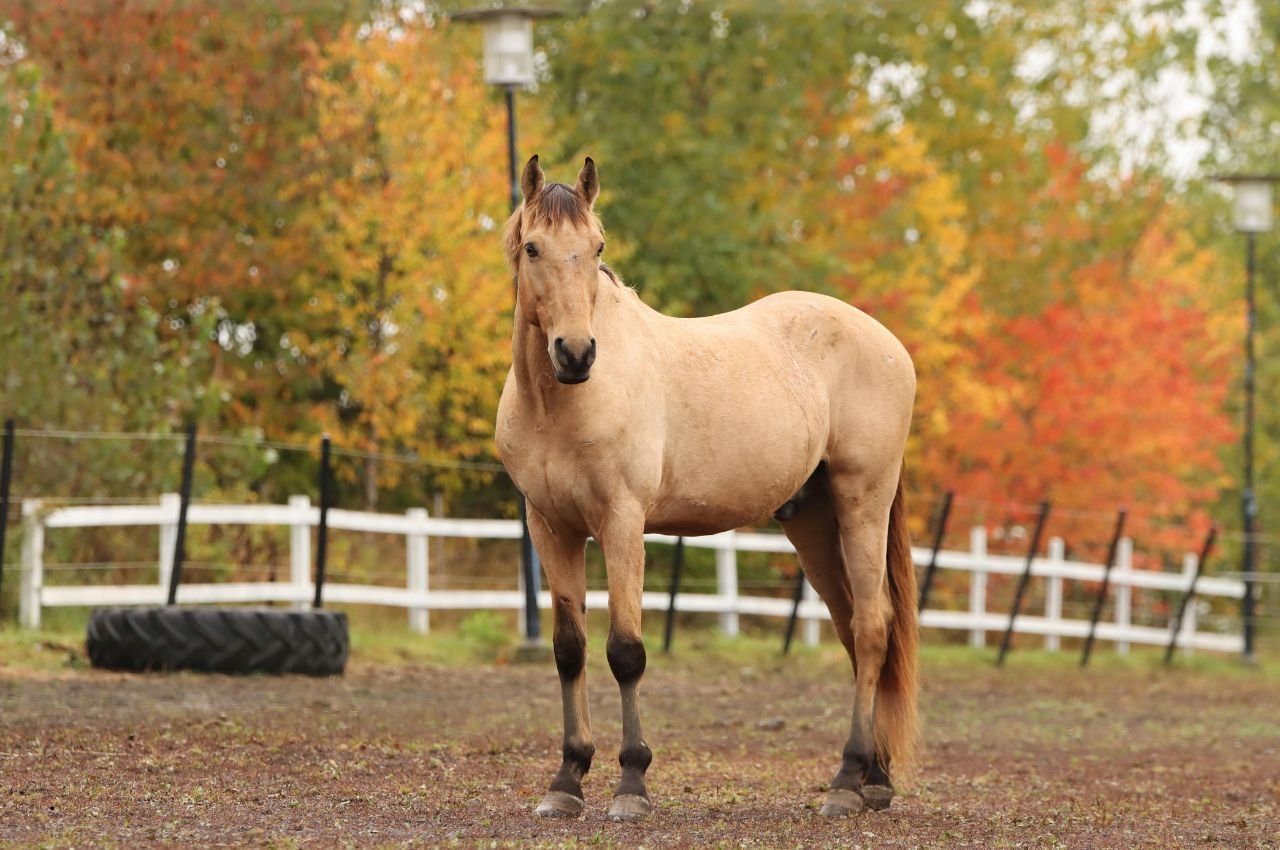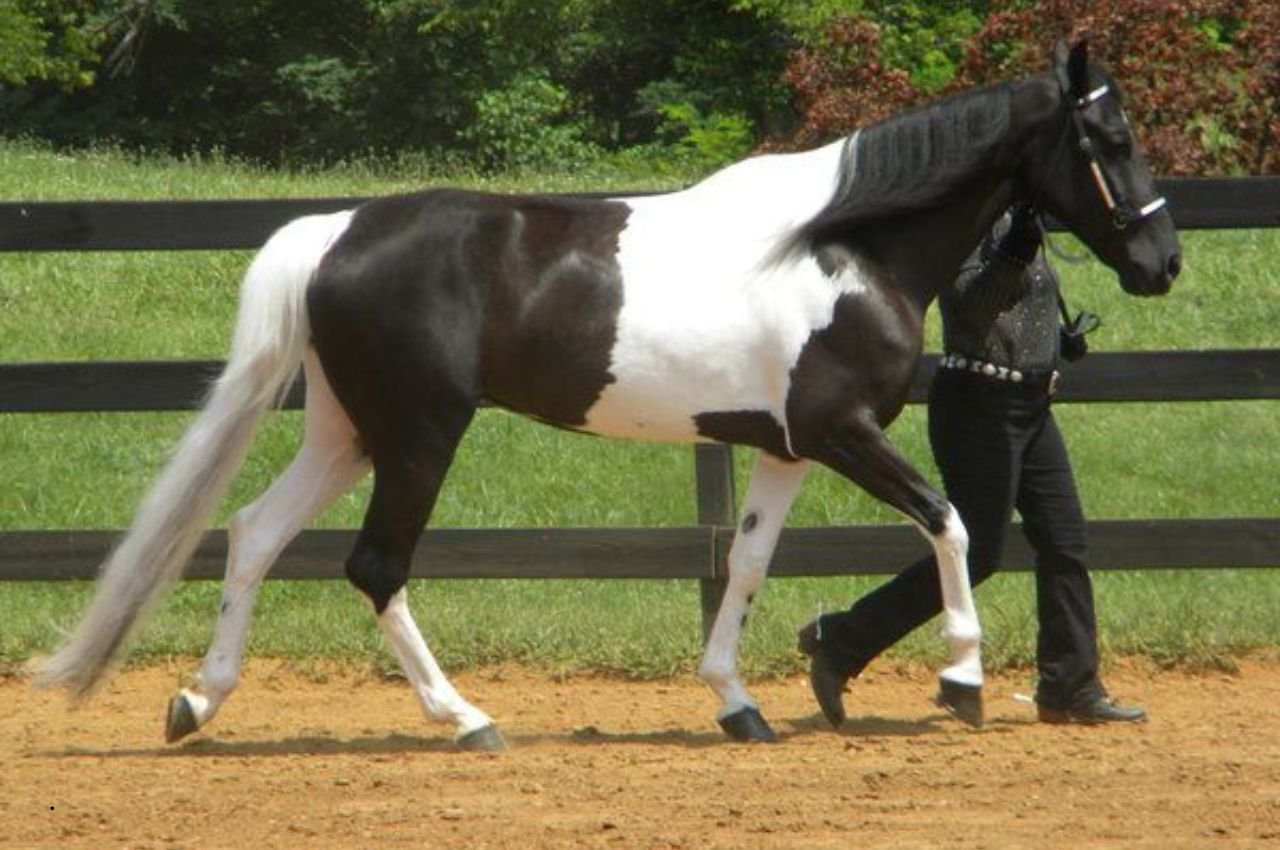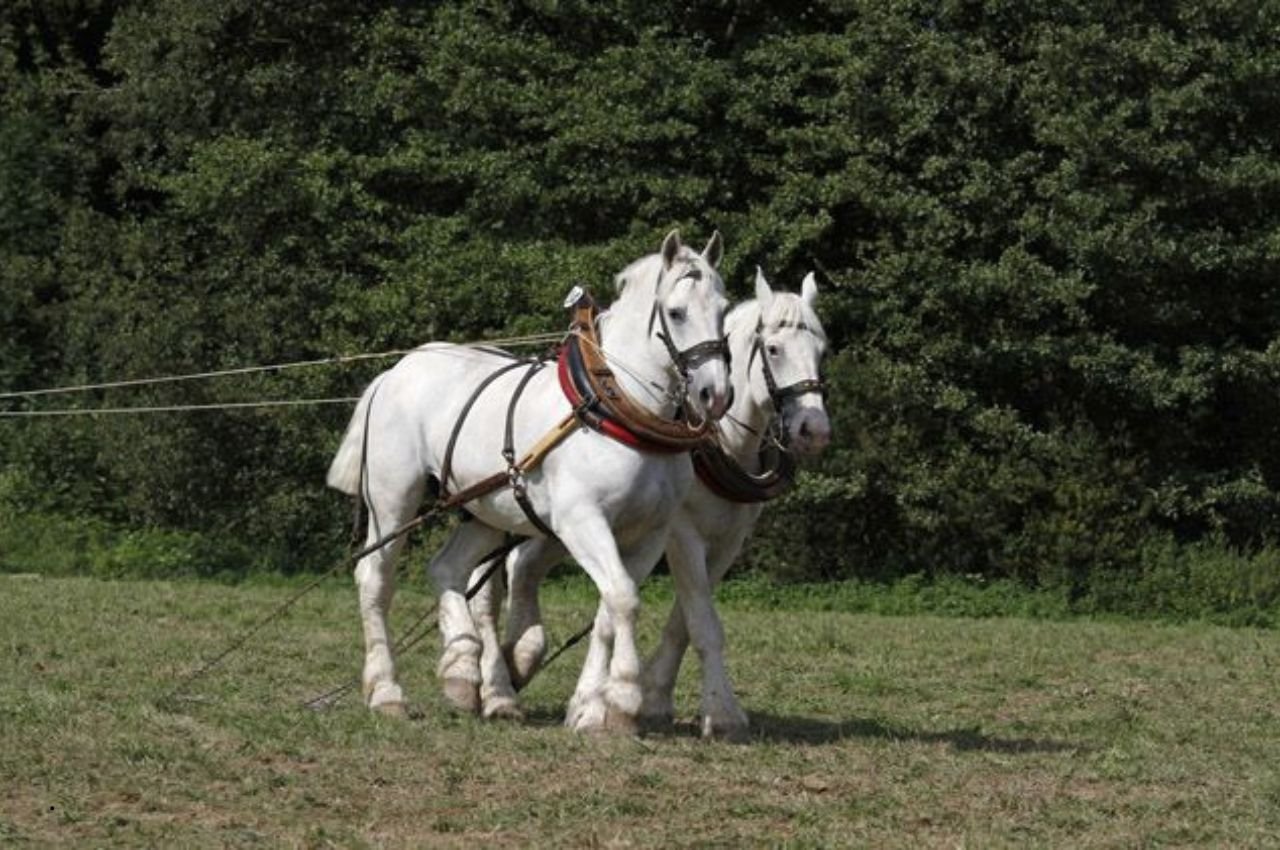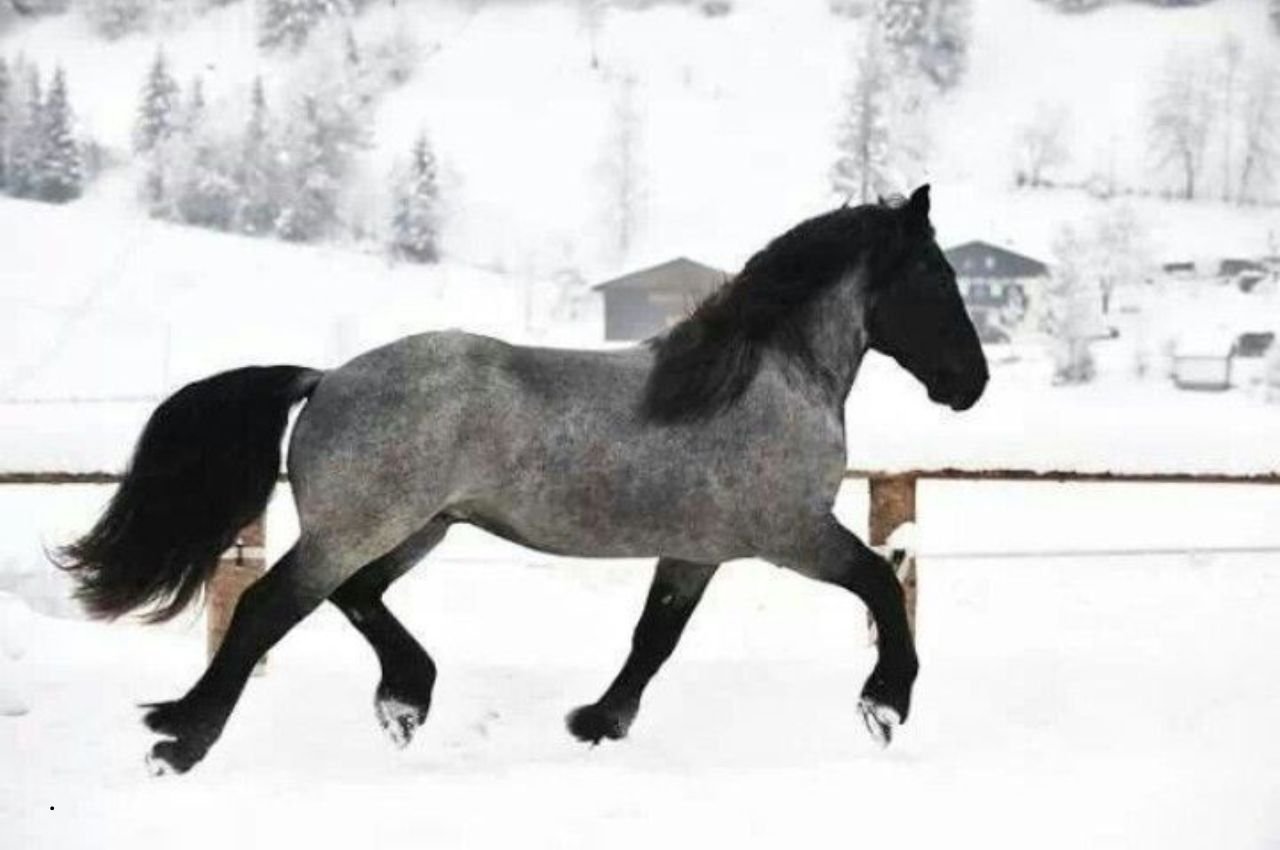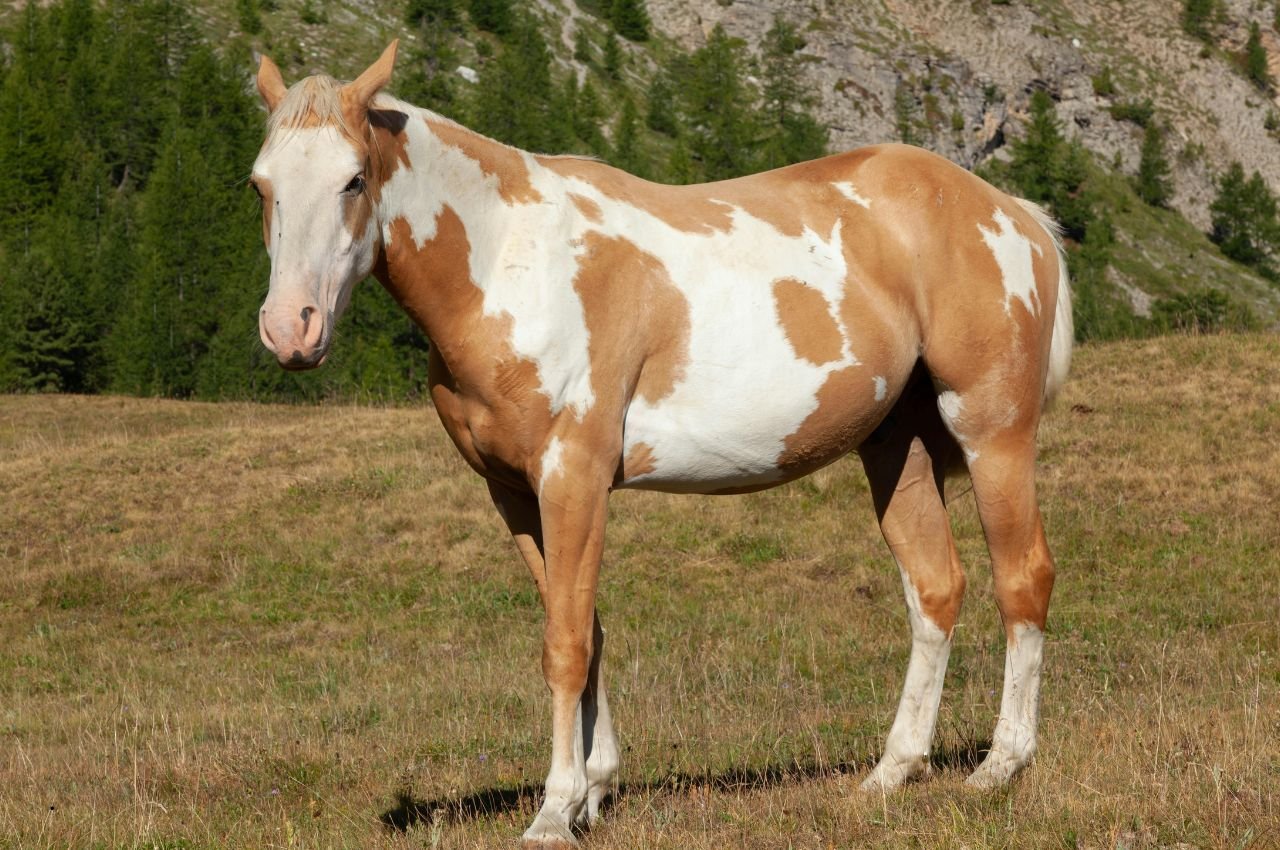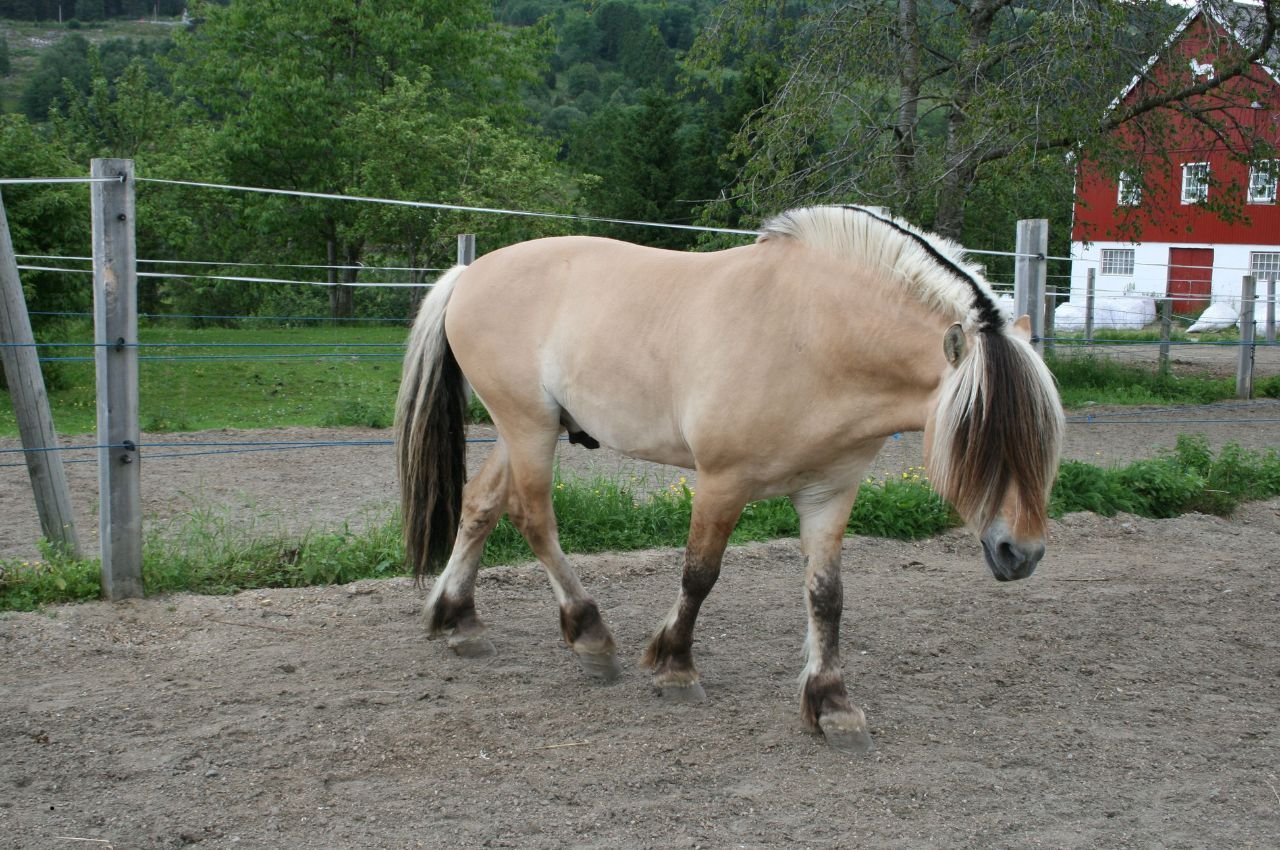The Italian Heavy Draft Horse, known in Italian as “Cavallo Agricolo Italiano da Tiro Pesante Rapido” (Italian Rapid Heavy Draft Agricultural Horse), stands as one of Europe’s most remarkable draft breeds. Developed through meticulous breeding programs that began in the mid-19th century, this extraordinary equine combines the raw power expected from heavy draft horses with an unusual degree of speed and agility that sets it apart from its contemporaries.
Combining the power of traditional heavy horses with surprising speed and agility, this breed represents centuries of careful selective breeding aimed at creating the perfect working horse for Italian agriculture and military purposes. What makes this breed truly exceptional is not just its physical capabilities, but its remarkable temperament and adaptability to various working conditions throughout Italy’s diverse agricultural regions.
What you’ll learn
Historical Origins and Development
The Italian Heavy Draft Horse’s fascinating story begins in 1860, when Italy’s Department of War initiated an ambitious and forward-thinking breeding program at the prestigious military stud of Ferrara. This wasn’t merely an attempt to create another heavy horse; it was a calculated effort to develop a breed that could meet the specific demands of Italian terrain and working conditions.
The breed dates back to 1860, when the horse production branch of the Department of War began the systematic crossbreeding of Breton stallions to carefully selected mares of the northeastern Italian plains. The foundation mares represented a diverse genetic pool of varied heritage, strategically chosen from Hackney, Belgian Draft, and Breton bloodlines to provide the best possible foundation for the new breed.
The initial breeding efforts focused on crossing native Italian stock with large Brabant horses from Belgium. However, while the resulting horses were strong, they were not light or fast enough for the farm work required of them by the Italians. This led breeders to introduce Percheron and Boulonnais blood to create a lighter, more agile animal without sacrificing strength.
After the First World War, stallions from the Ardennes, Percherons and especially Bretons (lighter and more active) were used. The systematic approach to horse breeding resulted in a horse that could excel in both agricultural work and military service. The breed’s official recognition came with the establishment of its stud book in 1961, cementing its place in equine history.
Breeding programs suffered during the war, and despite recovery efforts, population numbers continued to decline through the latter half of the 20th century, though dedicated genetic conservation efforts have worked to preserve this remarkable breed.
Physical Characteristics and Conformation
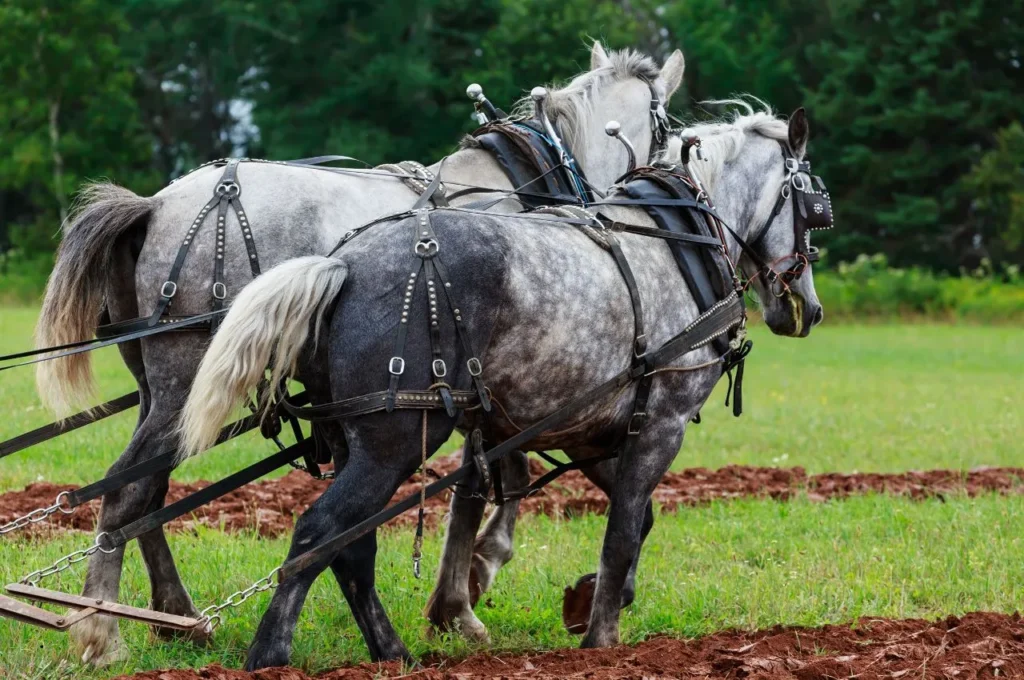
The Italian Heavy Draft is a medium-to-large draft horse that typically stands between 15 to 16 hands (60-64 inches) at the withers and weighs between 1,300 to 1,600 pounds. The breed exhibits several distinctive physical traits that set it apart from other draft horses.
Head and Neck
Italian Heavy Drafts have a wide head with small ears and a straight or convex profile, a short and thick neck that demonstrates both strength and refinement. The head is proportionate to the body size, displaying an intelligent expression with large, kind eyes that reflect the breed’s gentle nature.
Body Structure
The breed’s conformation reflects its dual purpose as both a powerful draft animal and a relatively agile working horse. The body is wide and heavily muscled with a short back that provides strength for heavy pulling work. A muscular, double croup, and short and thick legs complete the powerful frame that makes these horses exceptional for agricultural work.
Coat and Markings
Generally chestnut in color, the Italian Heavy Draft most commonly appears in various shades of chestnut, from light sorrel to dark liver chestnut. However, bay, brown, and occasionally roan colors also occur within the breed. The mane and tail can grow long and thick and be wavy, and the legs have light feathering, though not as extensive as seen in some other European draft breeds.
Temperament and Characteristics
The Italian Heavy Draft Horse is renowned for its exceptional temperament, making it highly valued not only for work but also for its ease of handling. Gentle, cooperative, and docile, they are very hardy, powerful, lively, and active. This combination of traits makes them suitable for both experienced horsemen and those new to working with large horses.
Working Attributes
The breed is known for its combination of strength and speed, which was the primary goal of its developers. Active gaits. Long stride. These characteristics allow the Italian Heavy Draft to perform sustained work at a pace faster than many traditional heavy draft breeds.
Maturation and Hardiness
The horses mature quickly and need no special care, which makes the business more lucrative. This practical advantage has contributed to the breed’s popularity among farmers and horse breeders who appreciate animals that require minimal specialized management while delivering maximum utility.
Feeding and Nutritional Requirements
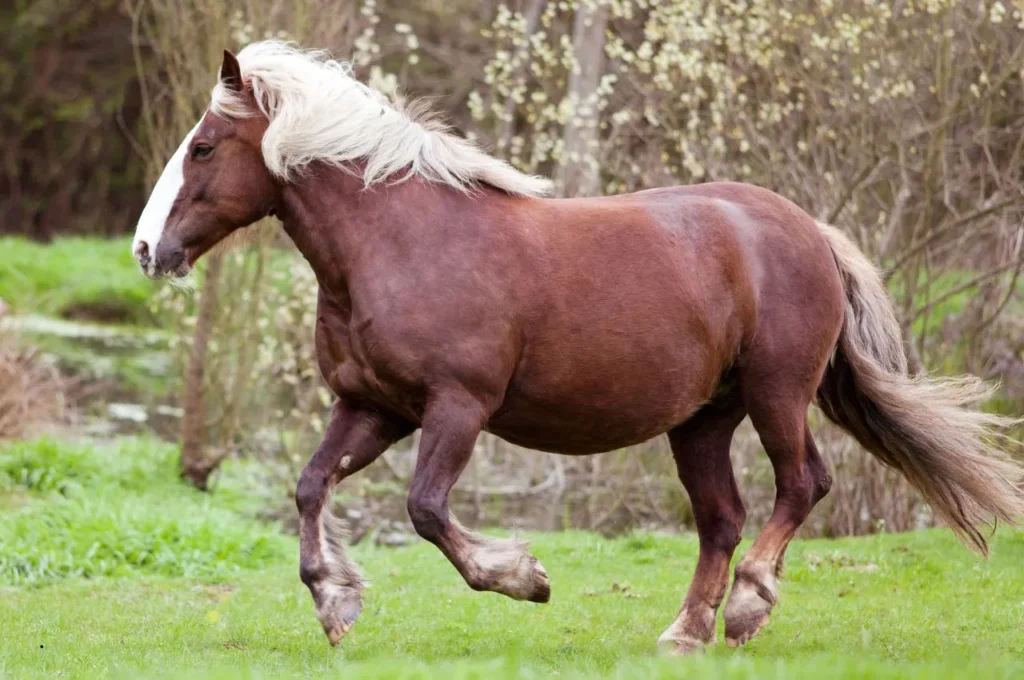
Proper nutrition is essential for maintaining the health, strength, and working ability of Italian Heavy Draft Horses. Due to their large size and potential for heavy work, these horses have specific dietary needs that must be carefully managed.
Basic Nutritional Principles
Like other breeds, mature draft horses should be fed a minimum of 1.5% of their body weight in forage daily, with a total intake between 1.5% and 3% of their body weight daily. For an Italian Heavy Draft weighing 1,600 pounds, this translates to approximately 24-48 pounds of feed per day, with the majority coming from high-quality forage.
The recommended amount of forage fed per day to any horse is 2.5% of their body weight per day. For example, if your draft horse weighs 1600 pounds, the recommended daily forage intake would be 40 pounds per day.
Forage Requirements
High-quality hay forms the foundation of the Italian Heavy Draft’s diet. The vast majority of drafts are exceptionally good doers, with good body condition scores on a forage only diet. Timothy, orchard grass, and mixed grass hays are excellent choices, while legume hays like alfalfa can be fed in smaller quantities to provide additional protein and calcium.
Pasture grazing should be managed carefully, as draft horses can easily become overweight on rich pastures. Rotational grazing systems help maintain pasture quality while preventing overconsumption.
Grain and Concentrates
They thrive on high-quality hay, pasture grass, and commercial grain mixes designed for draft breeds. The amount of grain needed depends on the horse’s workload, body condition, and individual metabolism. Working horses may require 6-12 pounds of grain daily, while horses at maintenance may need little to no grain.
Modern draft horses are typically fed both the grain and forage portion of their diet in two meals provided in the morning and evening. This feeding schedule helps prevent digestive issues and maintains consistent energy levels throughout the day.
Supplements and Special Considerations
Vitamin and mineral supplements may also be necessary, especially for pregnant or lactating mares. A quality vitamin and mineral supplement ensures the horse receives essential nutrients that may be lacking in forage and grain.
Most drafts do well on a basic diet of high amounts of lower quality grass hay and a mineral balance pellet. This practical approach recognizes that draft horses are typically efficient converters of feed and don’t always require premium feeds to maintain good condition.
Health Care and Management
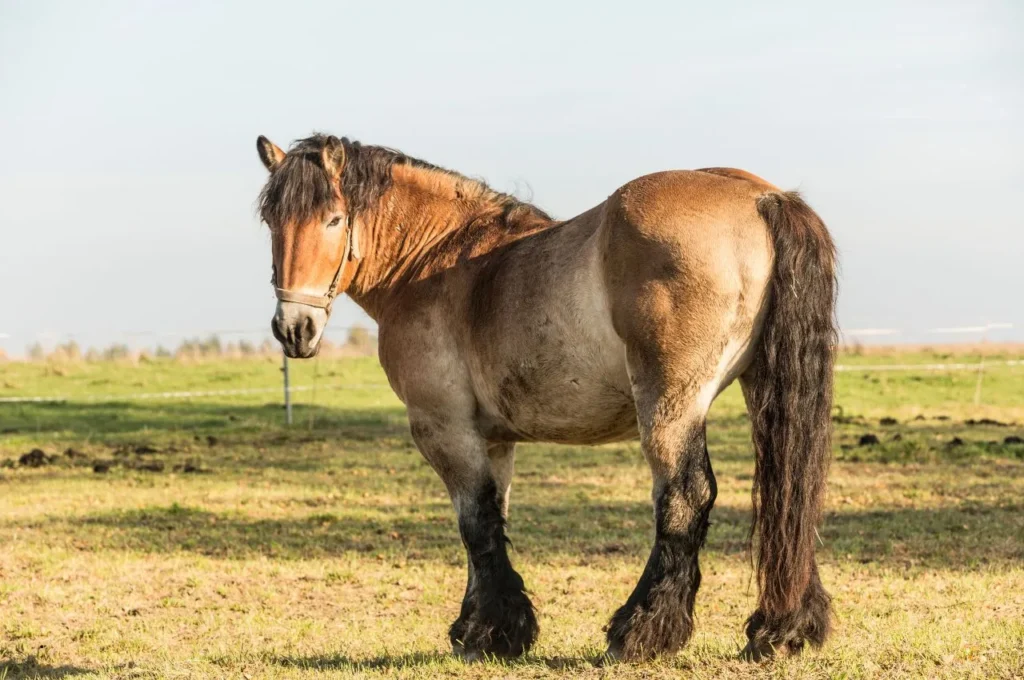
Italian Heavy Draft Horses are generally hardy and healthy animals, but like all horses, they require regular veterinary care and proper management to thrive.
Routine Health Care
Horses mainly kept in groups and extensively, having hay and water almost always ad libitum, and always provided with deworming treatments. Regular deworming, vaccinations, and dental care form the foundation of preventive health management.
Common Health Concerns
Due to their size and weight, Italian Heavy Draft Horses may be predisposed to certain conditions common in large horses, including:
- Joint stress and arthritis, particularly in working horses
- Metabolic issues if overfed or under-exercised
- Hoof problems due to their size and weight
- Respiratory issues if kept in dusty environments
Exercise and Conditioning
Regular exercise is crucial for maintaining the health and working ability of Italian Heavy Drafts. Even horses not actively used for work benefit from daily turnout and moderate exercise to maintain muscle tone, cardiovascular health, and mental well-being.
Modern Uses and Applications
While the Italian Heavy Draft Horse was originally developed for agricultural and military purposes, modern uses have evolved to meet contemporary needs.
Historical Uses
The Italian Heavy Draft was created with an aim to create a breed that would be equally skilled in agricultural activities as also, as a warhorse. Initially, these animals were bred to serve as a working horse both in the agricultural sector as well as in the Italian military.
Its versatility has led to its use in both agricultural and military capacities, as well as for the production of mules. The breed’s ability to produce quality mules when crossed with donkeys added another dimension to its economic value.
Contemporary Applications
Today’s Italian Heavy Draft Horses serve various purposes including:
- Agricultural Work: Traditional farming operations, logging, and land management
- Tourism and Recreation: Carriage rides, agricultural demonstrations, and educational programs
- Breeding Programs: Conservation efforts to maintain genetic diversity
- Therapeutic Programs: Their gentle nature makes them suitable for equine-assisted therapy
- Competition: Draft horse shows, pulling competitions, and driving events
Unfortunately, with Italy being one of the top consumers of horse meat, today, these horses are sometimes raised for meat production, though conservation-minded breeders focus on preserving the breed for its traditional qualities and uses.
Conservation Status and Future Prospects
The Italian Heavy Draft Horse faces challenges common to many draft breeds in the modern era. Mechanization of agriculture and changes in military needs have reduced demand for working horses, leading to declining population numbers.
However, renewed interest in sustainable agriculture, heritage breeds, and traditional skills has created new opportunities for the breed. Conservation programs, breed registries, and dedicated enthusiasts work to ensure that this remarkable horse continues to contribute to Italy’s agricultural heritage.
The breed’s combination of strength, speed, and gentle temperament positions it well for various modern applications, from sustainable farming practices to recreational driving and therapeutic programs. With proper management and continued breeding efforts, the Italian Heavy Draft Horse can maintain its place as one of Europe’s premier draft breeds.
Frequently Asked Questions (FAQs)
General Breed Questions
Q: How rare are Italian Heavy Draft Horses? A: The Italian Heavy Draft is considered a relatively rare breed with declining population numbers since the mechanization of agriculture. While exact current population figures vary, dedicated breeding programs and conservation efforts are working to maintain genetic diversity and breed numbers.
Q: What makes Italian Heavy Draft Horses different from other draft breeds? A: The primary distinguishing feature is their combination of strength and speed. Unlike many traditional heavy draft breeds that prioritize pure pulling power, Italian Heavy Drafts were specifically bred to be rapid heavy draft horses, capable of working at faster paces while maintaining substantial strength.
Q: Can Italian Heavy Draft Horses be ridden? A: Yes, Italian Heavy Draft Horses can be ridden, though they are primarily bred for driving and draft work. Their gentle temperament and steady gaits make them suitable for trail riding, though their size requires experienced riders and appropriate equipment.
Q: Are Italian Heavy Draft Horses good for beginners? A: While these horses have excellent temperaments described as gentle, cooperative, and docile, their large size (1,300-1,600 pounds) means they’re better suited for handlers with some experience managing large horses. Their kind nature does make them more forgiving than many breeds of similar size.
Care and Management
Q: How much space do Italian Heavy Draft Horses need? A: Like all draft horses, Italian Heavy Drafts need adequate space for exercise and grazing. A minimum of 1-2 acres per horse is recommended for pasture, with additional space beneficial for their physical and mental health. They adapt well to group turnout and extensive management systems.
Q: What special equipment do I need for an Italian Heavy Draft Horse? A: You’ll need draft-sized equipment including larger halters, bridles, and blankets. Standard horse equipment is typically too small. For driving, you’ll need appropriate draft harness and vehicles designed for their size and power.
Q: How long do Italian Heavy Draft Horses live? A: With proper care, Italian Heavy Draft Horses typically live 20-25 years, similar to other draft breeds. Their hardy nature and good health generally contribute to relatively long lifespans when well-maintained.
Q: Do Italian Heavy Draft Horses require special veterinary care? A: While they don’t require specialized veterinary care beyond what any horse needs, their size means some procedures may require veterinarians experienced with large horses. Regular preventive care including vaccinations, deworming, and dental work follows standard equine protocols.
Feeding and Nutrition
Q: How much does it cost to feed an Italian Heavy Draft Horse? A: Feeding costs vary by location and hay prices, but expect to provide 40+ pounds of forage daily plus grain as needed. Monthly feed costs typically range from $200-500 depending on local hay prices, grain requirements, and pasture availability.
Q: Can Italian Heavy Draft Horses live on pasture alone? A: Many Italian Heavy Draft Horses can maintain good condition on high-quality pasture alone, especially when not working. However, working horses, pregnant mares, and those on poor pasture will require hay and grain supplementation.
Q: What type of hay is best for Italian Heavy Draft Horses? A: Timothy, orchard grass, and mixed grass hays are excellent primary forages. Alfalfa can be fed in smaller quantities for additional protein and calcium. The key is consistent, high-quality forage rather than any specific type.
Q: How often should I feed my Italian Heavy Draft Horse? A: Most draft horses do best with 2-3 meals per day rather than once-daily feeding. This helps prevent digestive issues and maintains steady energy levels. Free-choice hay or frequent small meals are ideal when possible.
Training and Work
Q: What kind of work are Italian Heavy Draft Horses best suited for? A: These horses excel at agricultural work, logging, carriage driving, and any task requiring sustained power with moderate speed. Their rapid gait and endurance make them particularly suitable for farm work that requires covering ground efficiently.
Q: Are Italian Heavy Draft Horses easy to train? A: Yes, their cooperative and intelligent nature generally makes them responsive to training. They typically learn quickly and retain training well. However, their size requires confident, consistent handling from the start.
Q: Can Italian Heavy Draft Horses compete in shows? A: Absolutely! They can compete in draft horse shows, driving competitions, pulling contests, and agricultural demonstrations. Many also participate in educational programs and heritage festivals.
Conclusion
The Italian Heavy Draft Horse represents a remarkable achievement in selective breeding, combining the power needed for heavy work with the speed and agility required for efficient farm operations. From its origins in 19th-century military studs to its current role in conservation and specialty agriculture, this breed has consistently demonstrated its value through versatility, hardiness, and exceptional temperament.
For those interested in draft horses, whether for work, recreation, or conservation, the Italian Heavy Draft offers a unique combination of traits that few breeds can match. With proper care, feeding, and management, these horses can serve as both productive working animals and ambassadors for the rich heritage of Italian horse breeding.
References and Further Reading
For comprehensive breed information and historical documentation, the detailed Wikipedia entry on Italian Heavy Draft – Wikipedia provides an excellent starting point with extensive breed history and characteristics.
Visual breed identification and conformation details can be found at Horse Breeds Pictures – Italian Heavy Draft Information, which offers comprehensive photographic resources for understanding breed standards.
The comprehensive breed registry information is available through Horse Breeds List – Italian Heavy Draft, providing official breed statistics and current population data.
For detailed breed characteristics and modern applications, The Equinest – Italian Heavy Draft Horse offers contemporary insights into breed management and uses.
Historical breeding program information and European perspective can be found at Royal Horse – The Italian Draught Horse, providing context for the breed’s development within European horse breeding traditions.
Interactive breed information and gaming applications are available through Horse Isle – Italian Heavy Draft, offering engaging educational content about breed characteristics.
Scientific genetic research and breeding studies are documented in the peer-reviewed publication PMC – Mitochondrial DNA variation in the Italian Heavy Draught Horse, providing genetic diversity analysis crucial for conservation efforts.
Professional feeding guidelines for draft horse nutrition can be found at LMF Feeds – Feeding the Mature Draft Horse, offering expert nutritional recommendations from commercial feed specialists.
Comprehensive draft horse care information is available through Mad Barn – Draft Horse Breed Guide, providing detailed management practices for large horse breeds.
Advanced feeding strategies and nutritional science are covered in Tribute Equine Nutrition – Feeding Draft Horses, offering research-based feeding recommendations.
Current management and welfare research is documented in the academic publication Taylor & Francis – Management and welfare of the Italian Heavy Draft Horse, providing contemporary welfare assessment standards.
Research-based nutritional guidelines are available from Kentucky Equine Research – Feeding Draft Horses, offering scientific approaches to draft horse nutrition.
Practical feeding applications and real-world examples can be found at Foxden Equine – Feeding A Belgian Draft Horse, providing comparative insights applicable to Italian Heavy Draft management.
Additional breed information and ownership resources are available through PetCurious – Italian Heavy Draft Horse Breed, offering practical guidance for potential owners and enthusiasts.
This article provides general information about the Italian Heavy Draft Horse breed. Always consult with qualified veterinarians, equine nutritionists, and experienced horsemen for specific advice regarding individual horses.

